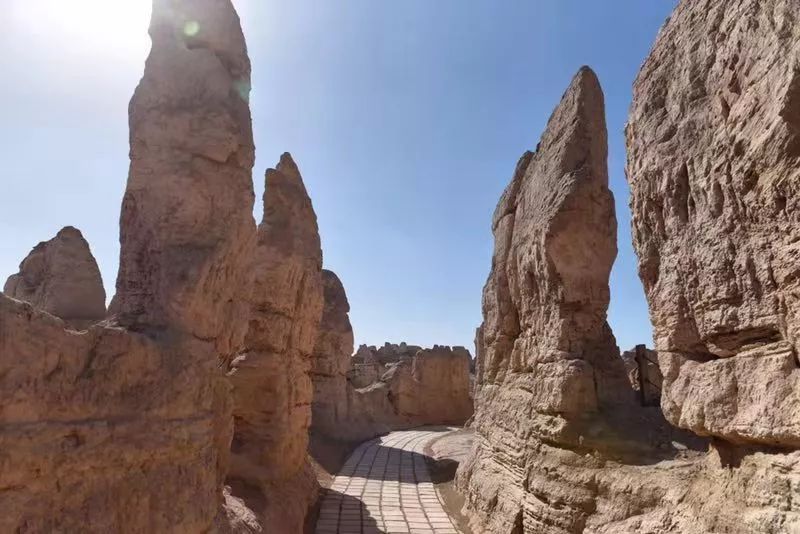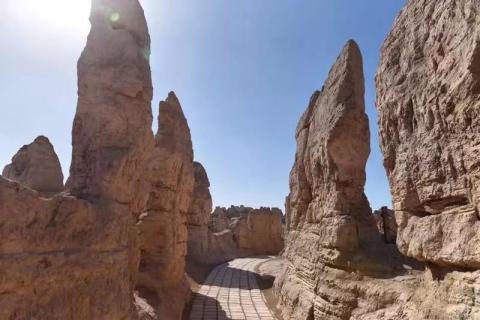Jiaohe Ancient City was briefly the seat of the Anxi Protectorate and played an important role in history. This city-state is more than 1,000 meters long and only over 300 meters wide. There are several Buddhist temples and 101 pagodas. What is even more amazing is that the entire city was dug down from the surface of the towering platform through " reducing land and leaving walls " . It can be said that the entire city It is a huge sculpture group.


View from the Jiaohe Ancient City Observation Deck
Among the thirty-six countries in the Western Region, Jiaohe is the so-called Cheshiqian country. There are only over 6,000 people in this country. Under the scorching sun, walking in the Jiaohe Old City where there are only a handful of tourists, if not fully armed, my skin would not be able to bear the burning of the high temperature. Looking up, there are ruins of walls covered with loess. There is not a single tree in the city, only scattered weeds and the occasional lizard, which reminds us that there is still life here. There are oasis areas in Turpan where there are karez, but the ancient city of Jiaohe is only about ten kilometers away from places such as Grape Valley, but the natural environment is very different. I wonder what it was like here back then. Going down the stairs to the former government district, there was only a section of tunnel and the walls of a few bedrooms. Imagine that the now plain earthen walls once had doors and windows open, and the walls were covered with colorful paintings. What a contrast!

Jiaohe Old Town Central Avenue
During the day, I climbed the mountain to watch the beacon fire, and at dusk, I drank my horse by crossing the river.Pedestrians are fighting in the wind and the sand is dark, and the princess Pipa is full of resentments.There are no city walls in the wild clouds, and rain and snow cover the desert one after another.Hu Yan flew away every night crying, Hu Er shed tears.If you hear that the jade gate is still covered, you should throw your life away.Every year, the bones of the war are buried outside, and it is rare to see Pu Tao entering the Han family.Walking in the ancient city and reciting this poem silently over and over again, it seems that I can get a glimpse of the scene that the poet saw when he came to Jiaohe area.More than 40 kilometers west of Jiaohe Old City, there is another ancient city relic - Gaochang Old City. Like Jiaohe Ancient City, it is also a world cultural heritage. The ruins of Gaochang Ancient City also show its past glory and the lofty status of Buddhism here. Gaochang Old City is not as narrow as Jiaohe River, but has a square layout. When we went there, there was no one else in the huge scenic spot. We were driving in the city on a scenic tour bus, passing by the Northwest Big Buddhist Temple, the Small Buddhist Temple, and the Pagoda... Although the walls were in ruins, it still revealed that this place was populated by Han people. The former glory of the Lord's oasis city-state. Every architectural ruin is covered in a golden coat under the setting sun, echoing the "burning" Flame Mountain in the distance, which is extremely magnificent.
Gaochang Ancient City at the foot of the Flame Mountain




Picturesque scenery under the sunset
The King of Gaochang of Qu clan had a legendary story with Xuanzang who passed by here to seek Buddhist scriptures: When Xuanzang was traveling west, he passed through Gaochang. The King of Gaochang, Qu Wentai, forced Xuanzang to stay in Gaochang to preach. Xuanzang went on a hunger strike in protest. Qu Wentai was moved by his determination and became sworn brothers with him. He gave him generous material support and agreed that when Xuanzang returns, he will go to Gaochang to preach for another three years. Unfortunately, when Xuanzang returned, Qu Wentai had died and the Gaochang Kingdom had been destroyed by the Tang Dynasty. Walking among the ruins of the Buddhist temple and looking up at the pagoda where Xuanzang once preached, although each niche is now empty, it still makes people imagine the grand scene at that time.
The largest Buddhist temple ruins in the ancient city of Gaochang

pagoda ruins

Unlike well-preserved historical relics, ruins are often incomplete because of their incompleteness. On the contrary, they can arouse people's questioning of history and lament the passage of time when imagining its original appearance. Jiaohe and Gaochang are like two wordless books, quietly displaying the unique charm of the Silk Road back then.



























